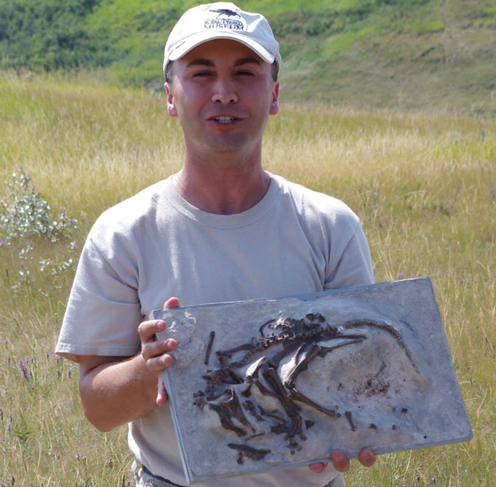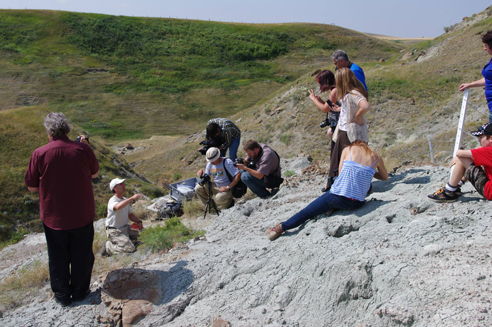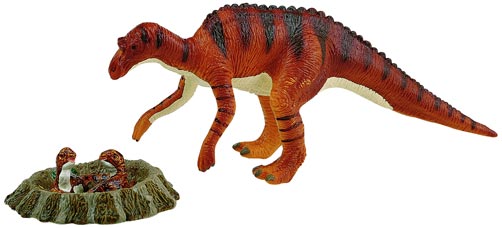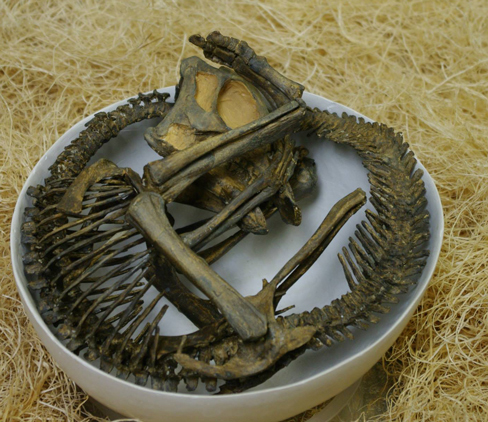Updates on Alberta’s Unique “Scrambled Eggs”
“Egg-citing” Times Ahead for Palaeontologists on Prehistoric Egg Hunt
With the summer excavation season drawing to a close and with wet and unsettled weather forecast, fieldworkers from the Royal Tyrrell Museum (Alberta, Canada) are in a race against time to identify and protect dinosaur eggs being eroded out of the hillsides at the Devil’s Coulee dig site. Earlier this week, the Royal Tyrrell Museum in association with the Devil’s Coulee Dinosaur and Heritage Museum held an open day, inviting the media and members of the public to tour the highly fossiliferous site located close to the small town of Warner (southern Alberta).
The Devil’s Coulee
Palaeoecologist Dr Francois Therrien identified a possible Maiasaura nest site at Devil’s Coulee and this week, the Drumheller based scientist conducted a tour of the Devil’s Coulee giving the media a rare insight into the current research work being undertaken.
Dr Francois Therrien with a Cast of a Baby Dinosaur
Picture credit: Devil’s Coulee Dinosaur and Heritage Museum
Campanian Faunal Stage
The mudstones in this area were formed around seventy-five million years ago (Campanian faunal stage of the Late Cretaceous) and they have yielded a number of fossil finds including dinosaur bones and turtle shells. However, the site is most famous for the numerous dinosaur eggs discovered and the fossilised remains of dinosaur embryos that have been found. Two different genera of giant, herbivorous dinosaurs used this area as a nesting site.
Maiasaura, whose fossils have been found in Montana in the main and a second duck-billed dinosaur known as Hypacrosaurus. Dr Therrien and his colleagues also believe that at least five different Cretaceous carnivores also nested at this location, just a dozen or so miles north of the Canadian/United States border.
The Media and Members of the Public are Taken on a Tour of the Fossil Site
Picture credit: Picture Credit: Devil’s Coulee Dinosaur and Heritage Museum
Dr Therrien commented:
“This is a really rich spot, the area is literally covered with dinosaur egg shells. Earlier this summer I was walking around the Devil’s Coulee and I saw egg shells breaking through the surface.”
Dinosaur Fossil Nests
The significance of the Devil’s Coulee site became apparent in 1987 when a local teenager exploring the site came across some strange objects eroding out of the soft mudstones. These turned out to be fragments of dinosaur eggs, since then, four fossilised embryos of the hadrosaur known as Hypacrosaurus have been discovered, including “Charlie”, a beautifully preserved baby dinosaur, one the most important baby dinosaur fossils known to science.
The Devil’s Coulee site was the first and so far only, extensive dinosaur nesting site to have been discovered in Canada, although the last nest to be excavated, that of a little carnivorous dinosaur called Troodon took place six years ago.
One of the problems with Devil’s Coulee is that there is a rapid rate of erosion. The harsh Canadian winters and hot summers have taken a terrible toll on the delicate fossils eroding out of the hillside. If sites such as this are not explored frequently then who knows what untold ancient treasures would be lost to the elements.
The best way to recover both fossilised eggs and any potential dinosaur embryos that may have been preserved is to identify fossil material at an early stage of erosion and then to carefully excavate and remove the surrounding rock. In this way, the large blocks containing the fossil material can be transported to a preparation lab and painstakingly excavated to reveal their fossilised secrets.
The eggs that Dr Therrien spotted are most likely those of a Maiasaura. The eggs are approximately the size of a galia melon.
A Model of a Maiasaura Dinosaur with her Nest
Picture credit: Safari Ltd
The picture above shows a Maiasaura dinosaur model with a nest.
To view models and replicas of Late Cretaceous, North American dinosaurs: Wild Safari Prehistoric World Replicas and Models.
Explaining How the Fossils are Excavated
The doctor explained:
“When the egg comes to the surface, it falls apart so in order to preserve it we have to collect a big block of rock and take it back to the lab. We know the eggs will be inside the block.”
The Royal Tyrrell Museum field team are also examining a second, nearby location that might be the remains of a Hypacrosaurus nest. Unfortunately, this delicate process, literally a case of “avoiding treading on egg shells”, may have to be suspended as bad weather is forecast in the area. Once September draws to an end, the nights are getting increasingly longer and the temperature begins to drop.
The permineralised remains of the eggs of dinosaurs are then subjected to frequent freeze/thaw actions with the onset of winter. This can lead to the fragmentation and break-up of any exposed fossil material. Field workers help to minimise this damage by covering potential dig sites with jackets of burlap and plaster. These afford some protection for the fragile fossils held in the rocks underneath.
One of the Most Important Vertebrate Fossils Found in Canada
Picture credit: Devil’s Coulee Dinosaur and Heritage Museum
We at Everything Dinosaur wish all those involved in the excavation and study the very best of luck and we thank the Devil’s Coulee Dinosaur and Heritage Museum for sending us some photographs of the media event.





